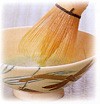Green teas, like black teas and oolongs, have several broad categories, with
their respective characteristics. The 6 most common categories are matcha,
sencha, gyokuro, hojicha, genmaicha, and bancha.
Matcha
 After the harvest, the
tea leaves are simply separated, dried, and powdered.
Rather than infusion, the
liquor is prepared by dissolving the powder in a small quantity of water,
using a special whip. This results in a somehow foamy liquor (as can be seen
on the opposite picture). Because
the leaves are powdered and entirely dissolved, all the nutrients they contain
are retained in the drink, which is a great merit of matcha, compared with
teas brewed by infusion.
After the harvest, the
tea leaves are simply separated, dried, and powdered.
Rather than infusion, the
liquor is prepared by dissolving the powder in a small quantity of water,
using a special whip. This results in a somehow foamy liquor (as can be seen
on the opposite picture). Because
the leaves are powdered and entirely dissolved, all the nutrients they contain
are retained in the drink, which is a great merit of matcha, compared with
teas brewed by infusion.
Matcha tea gardens receive special care. The plants are covered for some
time before harvest to control
exposure to sunlight. This results in
special sweetness and aroma, caused by the formation of amino acids.
Matcha is the tea used in sado, the traditional Japanese tea ceremony. Normally, a concentrated liquor, to be used by several persons in
turns, is made. That type
of drink is known as koicha. New buds from old trees are the best for
koicha. Progressively, however, a less concentrated liquor is made for individual
use. That one is referred to as usucha.
|
|
|
|
|
|
|
|
Gyokuro
Gyokuro tea plants also are covered for some time before the harvest, so they produce
amino acids that sweeten the taste of the liquor, like matcha. In fact, the
main difference from matcha is that the leaves are rolled after steaming. Gyokuro has a deep and strong taste. To get the best
Gyokuro drink, the
water should be boiled and cooled at around 50 degrees. For easier preparation,
our company has developed a new gyokuro (Netto Gyokuro) that can be brewed with hot water.
Sencha
This is the typical as well as the most common green
tea in Japan. Unlike matcha
and gyokuro, the plants are not covered. From sencha, several other
categories are made, either by treatment of the leaves or addition of other ingredients.
 Sencha
has two subdivisions: asamushi and fukamushi. The difference
between the two is in the steaming method. As the name indicates, asamushi
sencha is "light- steamed" (30 seconds to 1 minute), while fukamushi,
or "deep-steamed," is steamed for
a longer time (1 - 2 minutes). As a result of the deep steaming, the leaves of fukamushi
sencha break apart easily (as appears on this picture), and the liquor has less
aroma. Nonetheless, it has a fuller taste and can be brewed in hot water,
thus quicker.
Sencha
has two subdivisions: asamushi and fukamushi. The difference
between the two is in the steaming method. As the name indicates, asamushi
sencha is "light- steamed" (30 seconds to 1 minute), while fukamushi,
or "deep-steamed," is steamed for
a longer time (1 - 2 minutes). As a result of the deep steaming, the leaves of fukamushi
sencha break apart easily (as appears on this picture), and the liquor has less
aroma. Nonetheless, it has a fuller taste and can be brewed in hot water,
thus quicker.
Asamushi sencha is by and far the most commonly used. Actually. fukamushi sencha was
introduced only around 40 years ago. It got a momentum during the 1964 Tokyo
Olympics.
Genmaicha
It is made by adding roasted unpolished rice (genmaicha) to sencha.
Hojicha
It is made by roasting sencha of the 1st and 2nd flushes usually. It
is possible to use the large leaves or add kukicha (twig teas). The main feature of
hojicha is its strong aroma.
Bancha
Bancha is ordinarily made of 3rd flush and 4th flush leaves, which are steamed dry
and finally roasted. This tea is boiled directly in the kettle and then
served. Containing less caffeine, it is an excellent drink for children,
sick people, and the elderly.





